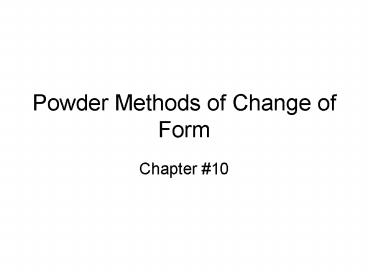Powder Methods of Change of Form - PowerPoint PPT Presentation
Title:
Powder Methods of Change of Form
Description:
Powder Methods of Change of Form Chapter #10 – PowerPoint PPT presentation
Number of Views:91
Avg rating:3.0/5.0
Title: Powder Methods of Change of Form
1
Powder Methods of Change of Form
- Chapter 10
2
Introduction To Powder Metallurgy
- Powder metallurgy is similar to casting in that a
shape can be created by the use of a mold. - The powdered solid material can be made to flow
in much the same way as a liquid. - Powder metallurgy is versatile and widely used in
industry.
3
Powder Metallurgy/Powder Forming
- Involves the compaction of finely powdered solids
into a mold and then fusing the particles
together. - Can be formed into a large variety of shapes to
meet industry needs.
4
5 Processes To Powder Metallurgy
- Preparation of the powdered material
- Blending of the powdered materials
- Filling the die with the powder and compaction
- Sintering (the process of bonding particles)
- Postsintering treatment to produce the final
dimensions and properties
5
Preparation and Blending
- Many types of metals and materials may be used
- Preparation of powder depends on physical
properties of material and type of final product
6
Brittle materials can be crushed to powder
Ceramics Glasses Bismuth
Titanium Antimony Carbide
7
Other methods for making powder include
- Grinding
- Plating it onto temporary surface and scraping
off - Melting and atomizing the metal
- Chemical reduction from an oxide
- Chemical precipitation from solution
- Solidification from the vapor stage
8
Making Powder
- Can be pulverized in a ball mill (10-1)
- Ground under water spray in inert gas
- Electroplating from a solution
- Melted and sprayed into inert gas
- Chemical precipitation (rust)
- Powder may need to be annealed to change physical
properties
9
Dry Lubricants
- Powders are often blended with dry lubricants for
even compaction - Stearic acid
- Lithium stearate
- Graphite
- Flammable metal powder must be mixed wet
10
Compaction
- Die for part is filled with prepared powder
- Then compressed from both bottom and top to
prevent compaction at pressure points - Process is called briquetting (10-2)
- Amount of pressure controls porosity and size of
final product - Part formed is called briquette or green compact
11
Compaction
- Powder can be compacted between two rollers
(10-3) - Forced through mild steel tube (extruding)(10-4)
- Explosive compacting (10-5)
- Compaction is economically feasible
12
(No Transcript)
13
(No Transcript)
14
(No Transcript)
15
Sintering
- Material is not melted
- Material is compacted under great pressure and
then heated to 60-80 of melting point - Sintering is the process of fusing the individual
faces of each particle atomically together (10-6) - Forms a true weld
16
Postsintering
- Three of the most common operations of
postsintering are - Infiltration
- Impregnation
- Sizing
17
Postsintering Infiltration
- Powder formed parts can be porous
- Other material can be placed in voids to enhance
the properties of the product - Iron based powder form voids can be filled with
bronze or copper - Increases the strength 70 to 100
- Absorbed by capillary action
- Also increases the density and hardness of part
18
PostsinteringImpregnation
- Most common postsintering process
- Used for bushings, bearings, cams, gears, pump
parts and many parts with wear surfaces - Permanently lubricates parts
- Oil fills the voids or pores of parts
- Can be impregnated under pressure, vacuum or
merely soaking
19
Sizing
- Powder formed and sintered parts can be sized by
machining, grinding and other methods - Another method is to force part through a die or
have a mandrel forced through part - Metal is not removed by this method but material
is further compacted - Sintered parts require less work to meet
tolerances
20
Applications
- The process of powder forming and powder
metallurgy is increasing in popularity - Has a vast area of uses in industry
- Processes continue to improve and grow in
application possibilities
21
Products Made by Powder Forming
- Wide variety of permanently lubed parts
- Used in many kitchen appliances, video recorders,
speedometer cables - Brushes on alternators, brake pads
- Powerful magnets, abrasive metals, dies
- Cutting tools end mills, thread taps, carbide
inserts - Metallurgy with coarse grain can be used as
filters, fuel elements for nuclear reactors, also
being extensively used in superconductor
technology
22
New Technology
- High velocity oxygen fuel (HVOF)
- Uses an internal combustion jet to generate
supersonic gas velocities - Molten powder sprayed at 67mph
- Surfaces of parts sprayed with considerable
impact to form a hard coat
23
Spray Forming
- Molten powder is sprayed on to build up shape
- Wide variety of materials can be used
24
Conclusion
- Powder metallurgy refers to those change-of-form
processes in which the material is made to flow
by powdering it. Powder metallurgy allows parts
to be made from materials that have very high
strengths, high melting temperatures, high
hardness, or are very brittle.

